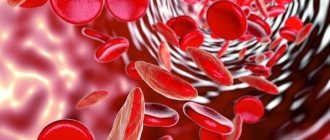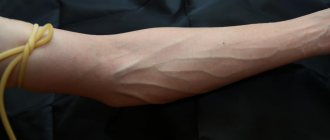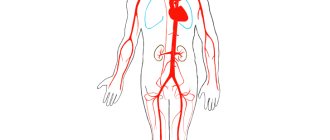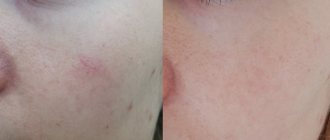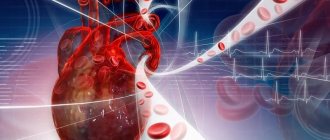01 Aug 2021 at 10:37 MRI of the heart in Tushino 11712
Atherosclerosis of the heart vessels is a disease in which fats and cholesterol are deposited in the form of plaques and deposits on the inner wall of blood arteries. As a result, the walls lose their elasticity and become compacted. As a result, the vessels become hard due to the fact that fats settle on their walls. The vessel may close completely. This process is accompanied by blood clotting disorders. People suffering from atherosclerosis are prone to thrombosis.
What it is
Blockage (occlusion) is an obstruction of blood vessels that appears suddenly, but is a consequence of long-term pathological processes in the tissues of the body. The main causes are blood clot formation and injury. Often, occlusion puts the body in a critical condition, requiring urgent medical intervention. To choose the right treatment strategy, it is necessary to determine the cause of the pathology.
If blood circulation weakens or stops in a section of the circulatory system, tissue oxygen starvation (ischemia) begins. Ischemia provokes tissue necrosis and other necrotic processes. To prevent a negative scenario for the development of the disease, medical care for blockage should be provided urgently.
Symptoms of vascular blockage
A feeling of discomfort occurs when the blockage is 50 percent or more. The set of symptoms depends on the location of the blocked fragment of the circulatory system. The following types of occlusions are considered the most dangerous:
- Blockage of heart vessels . Damage to the coronary vessels leads to the development of coronary artery disease. The initial signs of the disease are short-term attacks of angina. Their average duration does not exceed 10 minutes.
- Blockage of blood vessels in the legs . The disease manifests itself in pain and discomfort in the lower extremities. Often patients report decreased temperature of the legs, a predominance of a pale or bluish tint to the tissues.
- Occlusion of cerebral vessels . The severity of the pathology depends on the degree of blockage. The most common symptoms are recurrent or chronic headaches, high blood pressure, confusion, attacks of nausea, vomiting, and dizziness.
Consequences of the disease
Decreased blood permeability is a constantly progressive disease. Its development has different consequences for human life and health, but the symptoms and severity of the disease depend on the location of the outbreak. The initial stage of blockage of blood vessels in the extremities is characterized by pain and pulling sensations in the legs. If the obstruction continues for a long time, trophic ulcers appear and the tissues reach a state of necrosis. A patient diagnosed with necrosis is forced to agree to amputation of a limb in order to avoid the development of gangrene.
Ischemic heart disease contributes to the development of myocardial infarction. The higher the volume of the affected area due to obstruction, the more tissue is damaged.
Long-term occlusion of blood vessels leading to the brain also poses a danger to human health and life. Ischemia of brain tissue manifests itself in headaches and high blood pressure. If a person ignores these symptoms, they may miss the onset of an ischemic attack. This pathological condition progresses rapidly and often ends in a stroke.
Hormones, fat and genes
Yulia Borta, AiF: Konstantin Borisovich, what are atherosclerotic plaques in blood vessels? And why do they suddenly appear?
Konstantin Frolov : Atherosclerotic plaques are deposits of lipids, that is, fats. There are many theories about the development of atherosclerosis, but why this begins to happen is not completely clear. It has been established that heredity plays a major role in the development of the disease. As a rule, in patients who suffer from atherosclerosis, relatives were ill or died from its complications: stroke, heart attack, etc. No one disputes an excess of animal fats in food as the main provoking factor in the development of atherosclerotic plaques. The negative effects of smoking have also been proven. Among our patients, more than 90% are experienced smokers.
Article on the topic
Don't be afraid of fat. How to eat to get rid of atherosclerosis? However, following a healthy diet does not provide a 100% guarantee that the disease will not appear. There are interesting studies that have shown that through various hormonal manipulations it is possible to induce the development of significant atherosclerosis in herbivores that have not eaten a single gram of animal fat in their lives. So there are many theories on this topic, but none of them gives a comprehensive answer to the question about the causes of atherosclerosis. Therefore, we can fight, alas, only with its consequences.
— With excess fat it’s understandable. How does calcium appear in plaques?
— With pathological changes in the vessel wall, when its nutrition is disrupted, first fibrosis occurs, the formation of connective tissue, and then calcification, that is, the deposition of calcium in this area. This is the final stage of plaque development, when it becomes hard and stable. Before this, the plaque has a softer structure; parts of it can come off, “fly away” with the bloodstream and clog smaller blood vessels.
Diagnostics
People who come to a medical facility with complaints of symptoms of poor patency go through several diagnostic procedures. A thorough diagnosis is necessary to confirm or refute the diagnosis and select an appropriate treatment program. In addition to blood tests and other basic manipulations, an MRI of the heart and blood vessels located in the affected area is performed.
The MRI machine produces a detailed three-dimensional image, from which an experienced specialist can easily determine the degree of vascular patency, record traumatic injuries to veins and arteries, and the presence of plaques.
Thanks to MRI of brain vessels, the attending physician receives a detailed picture of the state of brain tissue, makes the correct diagnosis and proposes an effective treatment program. Timely treatment will protect the patient from disability and death due to the disease.
Hidden connections: how the condition of blood vessels affects skin and hair
The condition of hair and skin are the first signs by which we assess a person’s age. Beautiful thick hair and smooth skin speak of youth and health of the body. There are many products that promise to prolong the youth of skin and hair, including skincare and pharmacy cosmetics, nutritional supplements, and various cosmetic procedures. The vast majority of these products are aimed at directly affecting skin and hair cells. However, often the problem lies deeper.
Hormonal imbalances, disorders of the digestive tract and a number of other diseases affect the condition of hair and skin, so if it suddenly worsens, it makes sense to undergo a medical examination. Another common cause of cosmetic problems is a violation of blood microcirculation in the smallest vessels that nourish skin cells and hair roots.
What role do capillaries play?
The smallest vessels, capillaries, penetrate all the skin. Through them, cells receive oxygen and nutrients from arterial blood and have the opportunity to get rid of their waste products, which are carried away by venous blood. If a malfunction occurs in this well-functioning system, the metabolism of skin cells and hair follicles suffers, which leads to the appearance or aggravation of a number of cosmetic problems.
What cosmetic problems can be caused by insufficient blood supply to the skin and hair?
Impaired blood microcirculation can cause the following cosmetic defects:
- Premature aging of the skin
- in the absence of sufficient nutrition, skin cells cannot perform their function normally, which leads to the appearance of wrinkles, age spots, and loss of skin elasticity. First of all, this applies to facial skin, which is constantly faced with the aggressive effects of environmental factors.
- Hair loss
- hair follicles have two main phases of activity: anagen, accompanied by active hair growth, and telogen - natural hair loss and rest of the follicle. If there is insufficient blood supply, these phases become unbalanced, hair falls out too early, and recovery takes too long.
- Spider veins and rosacea
- in these cases, the cosmetic defect is the capillary itself, the walls of which become thinner and lose elasticity, as a result of which it begins to show through the skin. Most often, spider veins appear on the legs, which can also be the first symptom of varicose veins.
Cuperosis is spider veins on the face. They can appear as a result of external influences: overheating or hypothermia, frequent use of a handkerchief, the use of aggressive cosmetics - and disappear on their own. If this does not happen, rosacea indicates a general weakness of the capillary bed.
How to support capillaries?
If cosmetic problems are caused by fragility of capillaries and impaired blood microcirculation, it will not be possible to completely cope with them only with the help of cosmetics, and the effect of the procedures will most likely be temporary.
A sustainable result can only be achieved by strengthening capillaries and normalizing blood microcirculation. To restore the capillary bed, a drug called Vasalamin
. Its complex includes peptides, special protein compounds that trigger the process of cell regeneration and restoration of their normal function.
Each type of tissue has its own peptides; they are produced by our body independently, but after 25 years their synthesis slows down. Vasalamine complex
includes vascular cell-specific peptides that are identical to human ones. Thanks to this, they easily overcome the intercellular barrier and integrate into damaged vascular cells, starting the self-healing process.[1]
Vasalamin also saturates vascular cells with substances necessary for their metabolism.[2]:
· Vitamins A, B, E and PP
· Minerals: iron, magnesium, potassium, copper, etc.
· Amino acids: aspartic acid, glutamic acid, leucine, lysine, etc.
As part of studies of the course use of Vasalamin, its effectiveness in restoring the microvasculature has been proven. Also, while taking this complex, an improvement in the condition of the patients’ skin was recorded2. At the same time, Vasalamin does not cause side effects.
Why can a course of Vasalamine serve as preparation for a cosmetic procedure?
The use of Vasalamin allows you to combat directly the root cause of cosmetic defects caused by capillary fragility. However, even if blood microcirculation is restored, problems associated with its disruption may not go away immediately, especially if they are caused by a complex of reasons. In this case, it is advisable to use local care products and cosmetic procedures aimed at eliminating specific defects.
Thanks to a care product or procedure, skin and hair cells receive a resource for intensive restoration, and strong capillaries make the effect more long-lasting, providing the necessary nutrition and removal of metabolic products in the future.
[1] “Citamines are modern drugs with organotropic effects. Methodological recommendations", Military Medical Academy, Clinic of the Institute of Bioregulation and Gerontology, St. Petersburg 2009, pp. 22-24
[2] “Citamines are modern drugs with organotropic effects. Methodological recommendations", Military Medical Academy, Clinic of the Institute of Bioregulation and Gerontology, St. Petersburg 2009, p. 23
BIOLOGICALLY ACTIVE SUPPLEMENT. NOT A MEDICINE.
Treatment of vascular blockages
Early detection of pathology allows achieving good results in its treatment. If a patient comes to the clinic with initial symptoms, his treatment is limited to the prescription of medications. The attending physician determines the duration and intensity of the course, taking into account the current condition of the patient, his age and the intensity of the development of the pathology.
If the disease is not stopped early, drug treatment is unlikely to be helpful. Treatment at a later stage involves surgery. The internal cavities of the vessels are cleaned, the affected areas, if necessary, are removed. If the disease is too advanced, specialists perform amputation of the limb.
Regular preventive measures will help avoid the occurrence, development of the disease and its course in a negative scenario. The complex of preventive measures includes proper nutrition, giving up bad habits, moderate physical activity and living a stress-free life.



